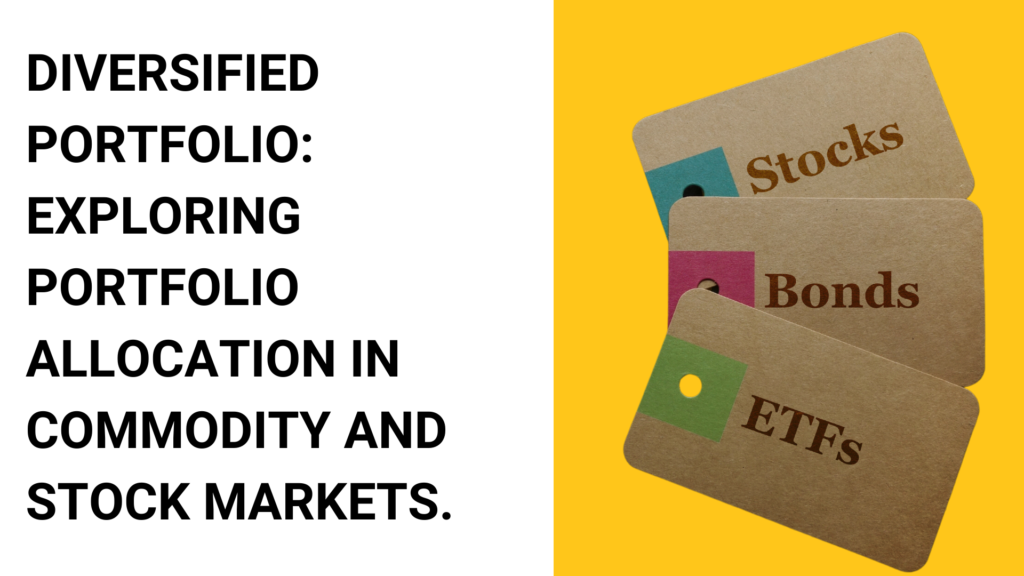
Building a strong and resilient investment portfolio is a goal for every investor. One effective strategy to achieve this is diversification, spreading investments across different asset classes to mitigate risk and maximize returns.
We will delve into the benefits and considerations of diversifying a portfolio across commodity and stock markets. By exploring these two distinct asset classes, investors can potentially enhance their portfolio performance and achieve long-term financial objectives.
Understanding Commodity and Stock Markets:
Commodity markets encompass a wide range of tangible assets such as precious metals, energy resources, agricultural products, and industrial materials. These markets are influenced by supply and demand dynamics, geopolitical factors, and macroeconomic trends. Commodity investments can act as a hedge against inflation and offer diversification benefits due to their low correlation with traditional financial assets.
On the other hand, stock markets represent ownership in publicly traded companies. Investing in stocks allows individuals to participate in the growth potential of businesses and benefit from capital appreciation and dividend income. Stock investments are influenced by company performance, industry trends, economic indicators, and market sentiment. Stocks provide opportunities for long-term wealth creation and portfolio growth.
Benefits of Diversifying Across Commodity and Stock Markets:
Risk Mitigation:
Diversifying across commodity and stock markets helps reduce the overall portfolio risk. These two asset classes have different risk profiles and tend to perform differently under various market conditions. When one asset class experiences a decline, the other may provide stability, thus offsetting potential losses.
Enhanced Returns:
By allocating funds to both commodity and stock markets, investors can potentially capitalize on different market cycles. Commodities often perform well during inflationary periods or when economic growth is robust, while stocks tend to thrive during periods of economic expansion. Diversification allows investors to capture opportunities and potentially enhance overall portfolio returns.
Portfolio Stability:
Including commodities in a portfolio can act as a buffer against stock market volatility. During market downturns, commodities like gold or oil can serve as safe-haven assets, maintaining stability and reducing the overall portfolio’s downside risk.
Inflation Protection:
Commodities, particularly precious metals and energy resources, have historically acted as a hedge against inflation. As inflation erodes the purchasing power of currencies, commodities tend to appreciate, preserving wealth and maintaining portfolio stability.
Asset Allocation:
Determine the appropriate allocation between commodity and stock markets based on individual risk tolerance, investment goals, and market outlook. A well-balanced portfolio considers factors such as time horizon, liquidity needs, and diversification benefits.
Research and Analysis:
Conduct thorough research on individual commodities and stocks before making investment decisions. Understand the fundamental factors affecting each asset class, monitor market trends, and consider expert opinions to make informed investment choices.
Regular Portfolio Rebalancing:
Periodically review and rebalance the portfolio to ensure that the desired asset allocation is maintained. Market conditions and performance may cause the allocation to drift from the original plan. Rebalancing helps realign the portfolio to its intended allocation and maintain diversification benefits.
Seek Professional Advice:
Investing in commodity and stock markets requires a deep understanding of the dynamics and potential risks. Consider consulting with a financial advisor or investment professional to gain valuable insights and personalized guidance.
Conclusion:
Diversifying a portfolio across commodity and stock markets can provide significant advantages for investors seeking a balanced and resilient investment strategy. By spreading investments across these two asset classes, investors can mitigate risk, enhance returns, and achieve long-term financial goals. However, it is crucial to conduct thorough research, consider individual risk tolerance, and regularly review the portfolio to ensure optimal diversification and alignment with investment objectives. With careful planning and informed decision-making, the power of diversification can be harnessed to navigate the ever-changing landscape of financial markets.
The key lies in understanding the characteristics, dynamics, and risks associated with each asset class, as well as regular monitoring and adjusting the portfolio to maintain the desired asset allocation. Through careful planning and strategic diversification, investors can harness the power of commodity and stock markets to build a robust and resilient investment portfolio that aligns with their financial goals.